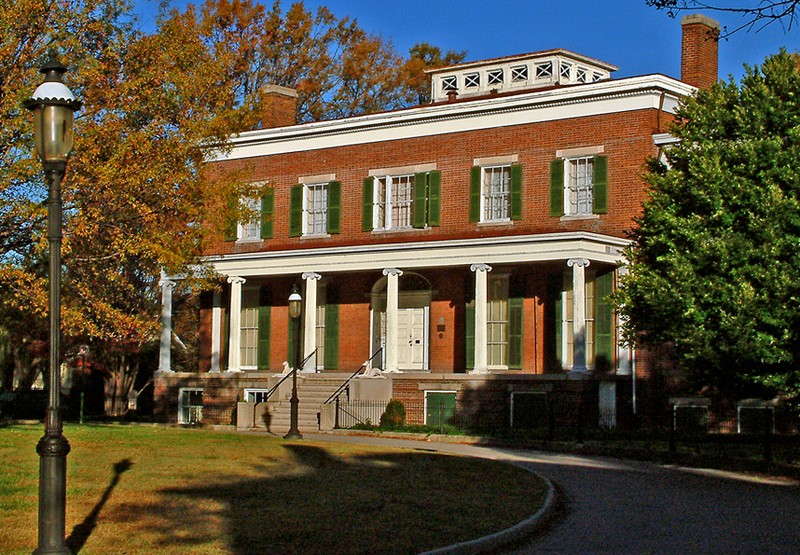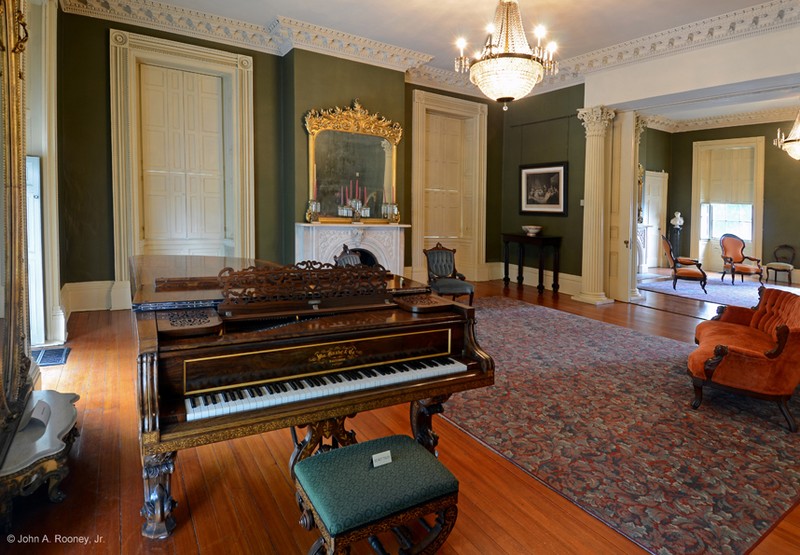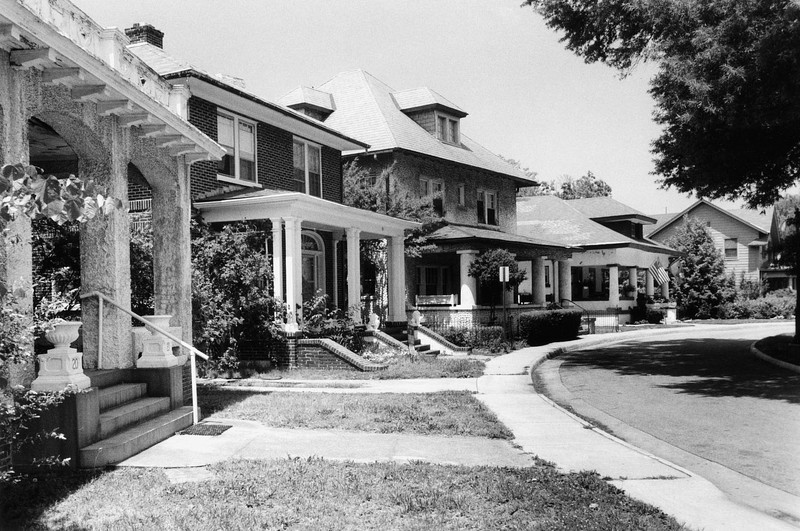Centre Hill Mansion
Introduction
Text-to-speech Audio
Built between 1818 and 1823, Centre Hill Mansion is an historic mansion overlooking the Appomattox River that has been home to a Revolutionary War veteran, a plantation owner, and a several social and political leaders. The residence was used as both a Confederate and Union headquarters during the Civil War. Owing to the influence of the families that called Centre Hill home, three United States presidents have paid visits to the house. Centre Hill was added to the National Register of Historic Places in 1972 and is part of the Centre Hill Historic District. It is now a museum open for tours.
Images
Centre Hill mansion is a beautiful example of Federal and Greek Revival architecture. Photo by Petersburg Museums.

The interior of Centre Hill mansion reflects the wealth and taste of the Bolling family. Photo by Petersburg Museums.

Bungalow and Foursquare houses in the nearby Centre Hill Historic District.

Backstory and Context
Text-to-speech Audio
Centre Hill Mansion may be best known for its beautiful architecture, which is the compilation of work by three of the property's owners. The first owner, Robert Bolling IV, built the mansion between 1818 and 1823. After serving as a cavalry captain in Revolutionary War, Bolling made his fortune in tobacco, building several warehouses along the Appomattox River in Petersburg. Bolling was the descendent of some of America's earliest settlers, including Robert Bolling of England and Jane Rolfe, the granddaughter of Pocahontas and John Rolfe. He built a Federal style mansion atop a scenic hill in Petersburg.
The symmetrical, rectangular shape and rows of windows are typical of the style named for the new government and nation. Bolling's son, Robert Buckner Bolling, added Greek Revival elements in 1850. While Federal architecture was partly inspired by ancient homes, Greek Revival's grand columnns made a bolder statement. Then, in 1901, attorney Charles Hall Davis initiated restorations of the house and landscaped grounds.1
The house has welcomed a number of famous visitors. The Bollings first hosted President John Tyler. During the Civil War, it served as a headquarters for both Confederate and Union leadership. In 1864, Confederate General James Longstreet occupied Centre Hill. Following the Third Battle of Petersburg in April 1865, which took place on the current Pamplin Historical Park property outside of the city, ten months of entrenched warfare ended. The city of Petersburg fell and Union Major General G.L. Hartsuff made his headquarters at Centre Hill. Shortly before the Confederate surrender at Appomattox, Abraham Lincoln visited Centre Hill to speak with Hartsuff and his soldiers. Less than a week later, Lincoln was shot at Ford's Theatre in Washington, D.C., and died on April 15.2
Decades later, the Civil War remained palpable. Centre Hill played a small role in larger stories of memorializing the conflict and segregation of the Jim Crow era. On May 19, 1909, President William Howard Taft visited Petersburg to dedicate a monument to Civil War General John F. Hartranft and his Pennsylvania troops. Afterward, Taft was an "honored guest" at a reception held at Centre Hill, which the Daily Press described as "one of the most beautiful old homes in all the Southland." In dedicating a monument to a Union soldier on former Confederate ground, Taft spoke of a "closer union of Northern and Southern hearts in a common love for the country."3 Meanwhile, the crowds remained divided, as white families gathered and children sang patriotic songs on the Centre Hill lawn, while "on the streets beneath the wall surrounding the mansion grounds, colored residents were gathered in the thousands."4 A speech centered around unity to a segregated audience was part of what historian David Blight calls a "romantic, sentimentalized road to reunion" in the Jim Crow era.5
While the mansion has remained relatively unchanged since the nineteenth century, the grounds surrounding Centre Hill developed. Today, these grounds are part of the Centre Hill Historic District, comprising 81 architecturally significant houses. While a few houses remain standing from an 1840s neighborhood, most were constructed after Charles Hall Davis sold the grounds to John H. Hayes's Centre Hill Company (later Centre Hill Building Corporation). Between 1914 and 1923, Hayes built a neighborhood with modest Colonial Revival, Bungalow, and American Foursquare houses. During World War I, Petersburg industry, and therefore its population, surged. To accommodate these new residents, new construction in the city rose by 450%.6 The neighborhood surrounding Centre Hill is part of this larger story of Petersburg's growth.
Today, Centre Hill Mansion is a museum belonging to the city of Petersburg. The mansion is restored and contains nineteenth and twentieth century furniture. The gardens were restored by the Garden Club of Virginia. With its beautiful architecture and grounds, Centre Hill has been featured in the PBS series Mercy Street and used in set design for Stephen Spielberg's Lincoln.7
The symmetrical, rectangular shape and rows of windows are typical of the style named for the new government and nation. Bolling's son, Robert Buckner Bolling, added Greek Revival elements in 1850. While Federal architecture was partly inspired by ancient homes, Greek Revival's grand columnns made a bolder statement. Then, in 1901, attorney Charles Hall Davis initiated restorations of the house and landscaped grounds.1
The house has welcomed a number of famous visitors. The Bollings first hosted President John Tyler. During the Civil War, it served as a headquarters for both Confederate and Union leadership. In 1864, Confederate General James Longstreet occupied Centre Hill. Following the Third Battle of Petersburg in April 1865, which took place on the current Pamplin Historical Park property outside of the city, ten months of entrenched warfare ended. The city of Petersburg fell and Union Major General G.L. Hartsuff made his headquarters at Centre Hill. Shortly before the Confederate surrender at Appomattox, Abraham Lincoln visited Centre Hill to speak with Hartsuff and his soldiers. Less than a week later, Lincoln was shot at Ford's Theatre in Washington, D.C., and died on April 15.2
Decades later, the Civil War remained palpable. Centre Hill played a small role in larger stories of memorializing the conflict and segregation of the Jim Crow era. On May 19, 1909, President William Howard Taft visited Petersburg to dedicate a monument to Civil War General John F. Hartranft and his Pennsylvania troops. Afterward, Taft was an "honored guest" at a reception held at Centre Hill, which the Daily Press described as "one of the most beautiful old homes in all the Southland." In dedicating a monument to a Union soldier on former Confederate ground, Taft spoke of a "closer union of Northern and Southern hearts in a common love for the country."3 Meanwhile, the crowds remained divided, as white families gathered and children sang patriotic songs on the Centre Hill lawn, while "on the streets beneath the wall surrounding the mansion grounds, colored residents were gathered in the thousands."4 A speech centered around unity to a segregated audience was part of what historian David Blight calls a "romantic, sentimentalized road to reunion" in the Jim Crow era.5
While the mansion has remained relatively unchanged since the nineteenth century, the grounds surrounding Centre Hill developed. Today, these grounds are part of the Centre Hill Historic District, comprising 81 architecturally significant houses. While a few houses remain standing from an 1840s neighborhood, most were constructed after Charles Hall Davis sold the grounds to John H. Hayes's Centre Hill Company (later Centre Hill Building Corporation). Between 1914 and 1923, Hayes built a neighborhood with modest Colonial Revival, Bungalow, and American Foursquare houses. During World War I, Petersburg industry, and therefore its population, surged. To accommodate these new residents, new construction in the city rose by 450%.6 The neighborhood surrounding Centre Hill is part of this larger story of Petersburg's growth.
Today, Centre Hill Mansion is a museum belonging to the city of Petersburg. The mansion is restored and contains nineteenth and twentieth century furniture. The gardens were restored by the Garden Club of Virginia. With its beautiful architecture and grounds, Centre Hill has been featured in the PBS series Mercy Street and used in set design for Stephen Spielberg's Lincoln.7
Sources
Associated Press. "A Great Day for Our Whole Country." Daily Press, May 20, 1909, pp. 1, 4. Accessed September 2017. http://chroniclingamerica.loc.gov/lccn/sn83045830/1909-05-20/ed-1/
Barnes, L. Diane. Artisan Workers in the Upper South: Petersburg, Virginia, 1820-1865. Baton Rouge: Louisiana State University Press, 2008.
Blight, David. "The Civil War in American Memory." In The Civil War Remembered. National Park Service, 2011. Accessed September 2017. https://www.nps.gov/resources/story.htm%3Fid%3D250
"Centre Hill." Petersburg Museums. Accessed September 2017. http://preservationpetersburg.org/museums/centre-hill/
National Park Service. "Centre Hill." National Register of Historic Places Inventory-Nomination Form. Prepared by Virginia Historic Landmarks Commission staff. Washington, D.C.: National Park Service, Department of the Interior, 1972. http://www.dhr.Virginia.gov/registers/Cities/Petersburg/123-0057_Centre_Hill_1972_Final_Nomination.p...
Keane, Katharine. "The Real-Life Inspiration for PBS's 'Mercy Street." Saving Places. National Trust for Historic Preservation. January 14, 2016. Accessed September 2017. https://savingplaces.org/stories/lisa-wolfinger-mercy-street-pbs
"Lincoln Movie Trail Sites." Virginia is for Lovers. Accessed September 2017. https://www.Virginia.org/Lincolnmovietrailsites/
National Park Service. "Centre Hill Historic District." National Register of Historic Places Inventory-Nomination Form. Prepared by Virginia Historic Landmarks Commission staff. Washington, D.C.: National Park Service, Department of the Interior, 1986. http://www.dhr.Virginia.gov/registers/Cities/Petersburg/123-0025_Centre_Hill_HD_1986_Final_Nominatio...
Poppeliers, John C. and S. Allen Chambers, Jr. What Style is it? A Guide to American Architecture. John C. Wiley and Sons: 2003.
Barnes, L. Diane. Artisan Workers in the Upper South: Petersburg, Virginia, 1820-1865. Baton Rouge: Louisiana State University Press, 2008.
Blight, David. "The Civil War in American Memory." In The Civil War Remembered. National Park Service, 2011. Accessed September 2017. https://www.nps.gov/resources/story.htm%3Fid%3D250
"Centre Hill." Petersburg Museums. Accessed September 2017. http://preservationpetersburg.org/museums/centre-hill/
National Park Service. "Centre Hill." National Register of Historic Places Inventory-Nomination Form. Prepared by Virginia Historic Landmarks Commission staff. Washington, D.C.: National Park Service, Department of the Interior, 1972. http://www.dhr.Virginia.gov/registers/Cities/Petersburg/123-0057_Centre_Hill_1972_Final_Nomination.p...
Keane, Katharine. "The Real-Life Inspiration for PBS's 'Mercy Street." Saving Places. National Trust for Historic Preservation. January 14, 2016. Accessed September 2017. https://savingplaces.org/stories/lisa-wolfinger-mercy-street-pbs
"Lincoln Movie Trail Sites." Virginia is for Lovers. Accessed September 2017. https://www.Virginia.org/Lincolnmovietrailsites/
National Park Service. "Centre Hill Historic District." National Register of Historic Places Inventory-Nomination Form. Prepared by Virginia Historic Landmarks Commission staff. Washington, D.C.: National Park Service, Department of the Interior, 1986. http://www.dhr.Virginia.gov/registers/Cities/Petersburg/123-0025_Centre_Hill_HD_1986_Final_Nominatio...
Poppeliers, John C. and S. Allen Chambers, Jr. What Style is it? A Guide to American Architecture. John C. Wiley and Sons: 2003.
